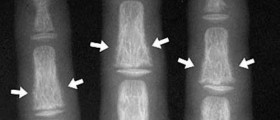
Hyperparathyroidism is a medical condition that affects the parathyroid gland and is characterized by excess of parathyroid hormone in the blood. Such huge and abnormal amount of the hormone occurs due to overactivity of the parathyroid gland. Humans have 4 such glands. They are rather small (approximately grain-of-rice size) and located next to the thyroid gland, in the neck. The hormone they produce is of major importance for balance of calcium in the blood.
An individual may develop primary hyperparathyroidism or secondary form of the disease. In primary hyperparathyroidism the excess of parathyroid hormone is associated with enlargement of the parathyroid gland i.e. the problem is in the very gland. Secondary hyperparathyroidism, on the other hand, develops as a result of other conditions that decrease the total amount of calcium in the blood. The parathyroid glands in such case overwork in order to compensate for inadequate amount of calcium. Secondary hyperparathyroidism affects patients who are already suffering from severe calcium deficiency, vitamin D deficiency and chronic kidney failure.
Who Gets Primary Hyperparathyroidism?
Under normal circumstance, the parathyroid glands control the level of calcium in the blood. So, if the level of calcium is low the glands secrete parathyroid hormone and restore the balance. The level of calcium gets back to normal thanks to calcium released from the bones or the one absorbed from the intestine. Once the optimal amount of calcium is achieved production of parathyroid hormone reduces and becomes normal again.
Excess of parathyroid hormone is blamed for rather high levels of calcium in the blood which is a cause of different medical issues. The levels of phosphorus are also affected. Namely, parathyroid hormone reduces the amount of phosphorus.
Primary hyperparathyroidism develops due to changes in one or more parathyroid glands. In the majority of cases there is adenoma affecting the gland. This is a benign secretory tumor, a common cause of excess of parathyroid hormone in the blood. Furthermore, the abnormal production of the hormone may occur due to glandular hyperplasia. And finally, the gland may be affected by a cancer.
Even though primary hyperparathyroidism affects people randomly, there are certain individuals who are at higher risk of developing the condition. Namely, the risk is higher in women who have entered menopause, people suffering from prolonged and severe deficiency of either calcium or vitamin D and patients suffering from certain inherited disorders (e.g. multiple endocrine neoplasia type 1). Additionally, the condition may occur in patients who have undergone radiation therapy of the neck due to a malignant tumor. Also, people who take lithium, a drug commonly prescribed for bipolar disorder, are at higher risk of developing problems with excessive production of parathyroid hormone.
It is estimated that primary hyperparathyroidism affects around 25-30 out of 100,000 people. The incidence of the disease is a bit higher in people between 15 and 65 years of age where 70-150 new cases are reported per 100,000 population. The condition also affects women 2-3 times more than men.
Dangers and Management of Primary Hyperparathyroidism
Dangers of hyperparathyroidism are related to the very excess of calcium that tends to accumulate in certain organs triggering their malfunction. The organs that suffer most damage are kidneys and bones although the condition almost equally affects the nervous system and other organ systems.
When the level of calcium exceeds normal range patients typically lose appetite, they are thirsty, urinate frequently and experience fatigue, muscle weakness and joint pain. Lethargy occurs as well. Patients are additionally constipated. In case the level of parathyroid hormone becomes too high, nausea, vomiting, severe abdominal pain and memory loss occur. Abnormally high level of calcium is blamed for depression.
It is essential to treat the condition as soon as possible since left untreated hyperparathyroidism triggers osteopenia/osteoporosis, bone fractures, kidney stones and peptic ulcers. Excess of calcium in the blood may initiate inflammation of the pancreas (pancreatitis) and neurogical abnormalities.
As far as treatment for hyperparathyroidism is concerned, it can be either conservative or surgical. Endocrinologists and surgeons are both included in the treatment of these patients.
This condition can be completely cured with surgical removal of the enlarged parathyroid glands, the ones affected by hypertrophy, adenomas or even malignant tumors. Prior to surgery it is essential to conduct a thorough evaluation and individual assessment of each and every patient. The goal is to remove the affected parathyroid gland by minimally invasive approach, sparing the surrounding tissues as much as possible.
Apart from minimally invasive parathyroidectomy, patients may also undergo parathyroid neck exploration (multigland disease) or parathyroid autotransplantation when all the parathyroid glands are affected. Patients who are candidates for surgery are those with extremely high level of calcium in blood as well as those with complications of the disease such as neurological complications, renal disease and bone disease. Finally, patients in whom symptoms of the condition become unbearable and are waiting to be operated are administered intravenous fluids and certain medications (e.g.calcitonin) that bring the level of calcium under control.
















Your thoughts on this
Loading...